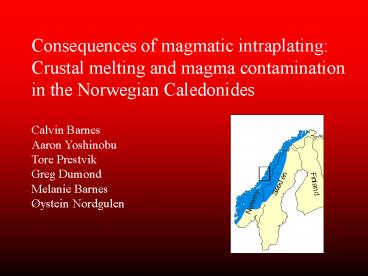Consequences of magmatic intraplating: - PowerPoint PPT Presentation
1 / 27
Title:
Consequences of magmatic intraplating:
Description:
Consequences of magmatic intraplating: Crustal melting and magma contamination in the Norwegian Caledonides Calvin Barnes Aaron Yoshinobu Tore Prestvik – PowerPoint PPT presentation
Number of Views:127
Avg rating:3.0/5.0
Title: Consequences of magmatic intraplating:
1
Consequences of magmatic intraplating Crustal
melting and magma contamination in the Norwegian
Caledonides Calvin Barnes Aaron Yoshinobu Tore
Prestvik Greg Dumond Melanie Barnes Øystein
Nordgulen
2
Magmatic intraplating Emplacement of hot, mafic
magma into lower or middle crust. Consequent
crustal melting, thought by some to be the
principal source of granitic magmas. Possible
mafic magma evolution due to --Fractional
crystallization (heat lost to melt host
rocks) --Magma mixing --Assimilation
3
Helgeland Nappe Complex Laurentian
affinity. Taconian-style deformation east-dippin
g, west- vergent thrust faults. Bindal
Batholith 475 to 430 Ma
4
- TIMING
- 500 to 490 Ma. Arc-related
- Ophiolites develop between large
- continental fragments. Locally-
- derived cover sequences.
- 2. 477 to 468 Ma. Medium-grade
- metamorphism of ophiolite
- fragments and cover sequences.
- High-grade metamorphism of
- the shelf sequences. Migmatization
- of appropriate lithologies.
- 3. 468 to 448 Ma. Imbrication of
- alternating thrust slices of
- medium- and high-grade rocks.
- 4. 448 to 435 Ma. Emplacement
5
VELFJORD 448 to 445 Ma Pluton emplacement at 7
8 kbar liquidus Ts near 1240ºC----- intraplating.
Melting of pelitic host rocks within 1 km of
contact. Local concentration of contact
granite.
6
SAUSFJELLET PLUTON Two intrusive stages. In Stage
2, quartz, hornblende, incompatible elements,
d18O all increase from central to west
East side in contact with marble and related
refractory metasedimentary rocks.
West side in contact with metapelitic
diatexites, which are partly melted in the
aureole.
7
(No Transcript)
8
(No Transcript)
9
(No Transcript)
10
amphibole cpx monzodiorite
amphibole cpx nepheline diorite
11
(No Transcript)
12
(No Transcript)
13
(No Transcript)
14
Regional migmatites muscovite biotite garnet
sillimanite staurolite
15
Contact diatexites sillimanite garnet biotite
16
SAUSFJELLET PLUTON Two intrusive stages. In Stage
2, quartz, hornblende, incompatible elements,
d18O all increase from central to west
East side in contact with marble and related
refractory metasedimentary rocks.
West side in contact with metapelitic
diatexites, which are partly melted in the
aureole.
17
d
O
18
14
Sausfjellet pluton Stage 2.
host migmatites
12
and granite
10
western/annular
8
zone
central zone
6
0
5
10
15
MgO
18
d18O
ppm Zr
19
(No Transcript)
20
(No Transcript)
21
Medium-grade metamorphism of ophiolites and cover
sequences. High-grade metamorphism of the shelf
sequences. Migmatization of appropriate
lithologies.
Arc-related ophiolites develop between large
continental fragments. Locally-derived cover
sequences.
Imbrication of alternating thrust slices of
medium- and high- grade rocks.
Emplacement of dioritic to granitic plutons.
Melting in some pluton aureoles.
One tectonic scenario for the Helgeland Nappe
Complex
22
High-K (granitic) leucosomes. Migmatites are
refractory. Diatexites are the most
refractory. Contact granites 1. A distinct
compositional trend. 2. Felsic part of trend
overlaps high-K leucosomes. 3. Mafic part of
trend IS NOT co-linear with migmatite trend.
23
(No Transcript)
24
(No Transcript)
25
(No Transcript)
26
High-K (granitic) leucosomes isotopically
similar to migmatites.
Contact granites Nd and oxygen isotopes are
intermediate between leucosomes and diorites.
27
GEOLOGIC SETTING Caledonian fold beltcollision
of Laurentia and Baltica beginning at about 430
Ma and ending at about 400 Ma. Emplacement of
four allochthons on the Baltic craton. Uppermost
Allochthon Exotic to Baltica. Geologic history
distinct from allochthons formed near the
Baltic craton. Amalgamated during Ordovician
time, probably close to Laurentia. Consists of
ophiolite-floored metasedimentary units and
high-grade shelf sequences.






![❤️[READ]✔️ The Social Consequences of Long Life PowerPoint PPT Presentation](https://s3.amazonaws.com/images.powershow.com/10059758.th0.jpg?_=202406191111)
![[Read] The Social Consequences of Long Life PowerPoint PPT Presentation](https://s3.amazonaws.com/images.powershow.com/10060010.th0.jpg?_=20240621011)
![❤️[READ]✔️ The Social Consequences of Long Life PowerPoint PPT Presentation](https://s3.amazonaws.com/images.powershow.com/10057876.th0.jpg?_=20240618035)






















